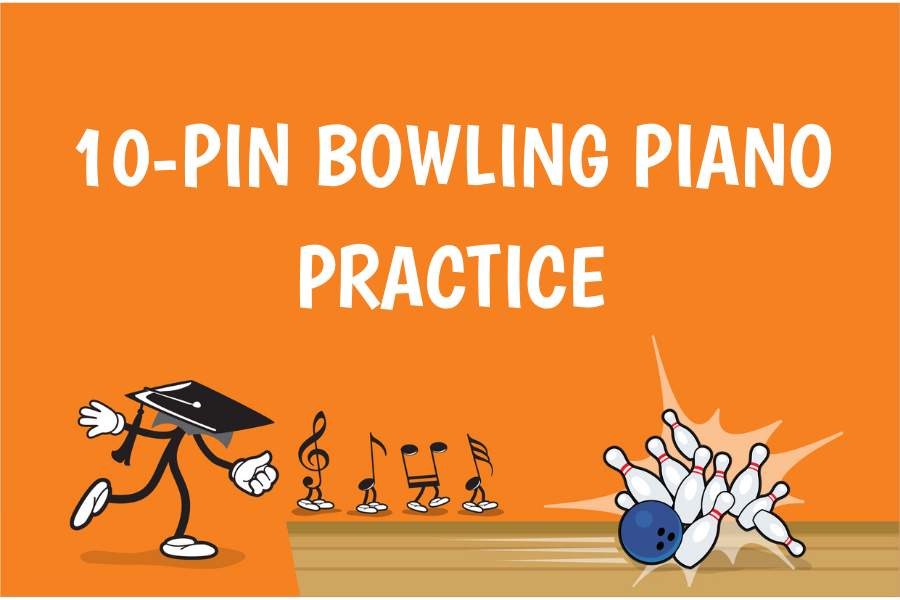10-Pin Bowling Piano Practice

My parents were, back in the day, really awesome at ten-pin bowling. (I promise that this will lead to a piano practice incentive!) I used to go along to watch them compete sometimes, but I could never quite work out how the bowling scores worked. Strikes are worth 10 points, yes? But 12 strikes in a row is a ‘perfect game’… which somehow equals 300… huh?
Now that, decades later, I DO understand the scoring system, I’m going to give you a very quick rundown, for the purposes of being able to relate this to piano practice. 1
STRIKE: knock all 10 pins down = 10 points PLUS whatever you score in the next two shots
SPARE: knock all 10 pins down, but take two turns to do it = 10 points PLUS whatever you score in the next shot
So, if you bowl three strikes in a row, you actually get 30 points for the first strike, because you get the bonus of the next two balls (which were both strikes!). If you keep bowling strikes, you end up with 30 points for each of them, which is how you can get a perfect score of 300. 2
If, like me, you follow your one and only strike with two gutter balls 3, you’ll only get 10 points for that strike. Same if you follow your ‘spare’ with one gutter ball. The bonus is wasted. 4
I’ll spare you (see what I did there??) the full explanation of all the different scoring scenarios, but this got me thinking about how this is a great way to view the impact of piano practice. It’s the frequency that is so important. The more frequently you practise, the more you get the ‘bonus’ from the previous practice.
I’m sure you can tell where this is going. That’s right… this term I’m going to run “10-Pin Piano Practice” with my students!
I’m going to give bowling names to the types of practice they might do:
STRIKE: really great, long, productive piano practice = 10 points PLUS the points from practice in the next TWO days
SPARE: good practice = 10 points PLUS the points from your practice the next day
GUTTER BALL: no practice
We’ve all come across that student who thinks they can get away with doing the whole week’s practice on one day. But in this scenario, even if they did a fantastic long practice (‘strike’), it will be followed up with six ‘gutter balls’, and this will not only negate the bonus but will actually wipe out any impact at all from that strike. 5
Even if practice is shorter and less effective (‘spare’), there is still benefit to be had… simply do it again the next day and you’ll improve. Bonus improvement! But if you don’t practice the next day (gutter ball), the impact is lost – no bonus improvement.
This term, my students will rate their practice each day, in bowling terms. I’ve included an extra term, ‘split’ – which in bowling is better than a gutter ball but not great. Here is the points/naming system I’ve come up with.
| Description | Points | Bonus | |
|---|---|---|---|
| STRIKE | Awesome, longer-than-usual, very productive practice | 10 | Add on points from the next TWO days |
| SPARE | Good practice, usual length | 10 | Add on the points from the next day |
| SPLIT | Short, not-very- efficient practice | 5 | No bonus |
| GUTTER BALL | No practice | 0 | No bonus |
I’m going to give them a chart to fill in at home. All they have to do is write down whether they got a strike/spare/split or gutter ball, according to the descriptions above. We will add up the points and do all the maths when they come to their lesson. (EDIT: I have now designed a cool scoresheet for students to keep track of their practice. Download it here!)
I’m hoping they will soon realise that by following up their strikes or spares with more strikes or spares, they will be getting lots of bonus points, and also realise that by not following up the next day, they’ll be missing out! The goal is to get them into a really excellent practice habit.
I’m yet to decide how this might work in terms of a studio challenge, and whether students will see each other’s scores and be motivated by them. I’d love to hear your ideas!
- If you already know how bowling scores work, skip to paragraph three. 😊
- I know, I know…12 strikes x 30 points each = 360. To quickly explain, if you get 9 strikes in a row, that’s 270, and then in the last frame you need to bowl 3 strikes in a row which are worth 10 each. Ta da! 300 game. I didn’t make this up.
- Because I did not inherit any bowling skills, apparently. But my sister did. She came 4th in a national competition, as a 13 year-old.
- Boo hoo
- As I write this I realise I’m very lucky that each of my bowling games had no impact on the next.

I think you need to keep following the Bowling analogy on with the competition element. Each week there is a champion and by the end of term there maybe a grand champion. If not several! Maybe have teams based on age range or grade level?
I do love your creative ideas.
This is an awesome idea, thanks Helen!
Can you demonstrate how to use the chart please Samantha?
Hi Connor it’s just a matter of documenting the various types of practice and then adding up the scores at the end of the week. It works just like a bowling card!